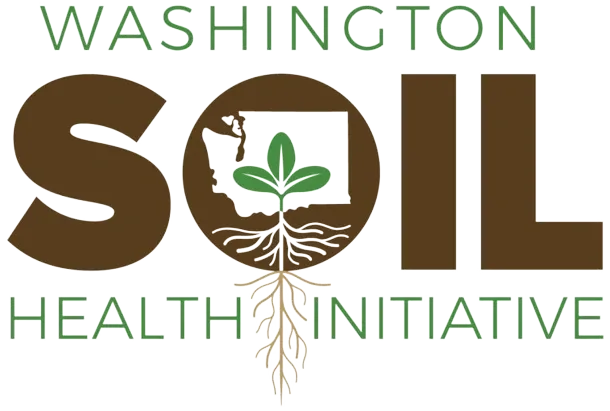
© Leslie Michel, WSDA
Soil Health Ambassador: Reid Wilson and improved undervine cultivation
Learn from the Vineyard Manager of Hedges Family Estate about why and how they’re rethinking soil management under the grape vines in their vineyards.
June 16, 2025
Author: Leslie Michel, Washington State Department of Agriculture, Quotes from Reed Wilson
Introducing the Hedges Family Estate
On Red Mountain, just outside of Benton City, sits 110 acres of certified biodynamic vineyards owned by Tom & Anne-Marie Hedges. The Hedges Family Estate grows many grape varietals including Cabernet Sauvignon, Cabernet Franc, Malbec, Merlot, and Grenache. They use a variety of practices to improve the health of their soil, including cover cropping, berm removal, and integrating chickens for weed control.
Vineyard Manager Reid Wilson previously worked in southern Oregon, Napa, and Sonoma, but moved to Washington for our “very, very sandy soils” and their ability to produce world class wine. Reid’s passion for soil health stems from the soil’s direct effect on the grapes.
He noticed how, in conventional vineyards, farmers often treat the symptoms of unhealthy soil, rather than improving the soil itself. Reid began learning how to bring health back to the soil, and subsequently the vines. Over time, he’s seen the practical and economic benefits of improving soil health, such as lower water requirements and improved crop yield.
“I view myself more as an observer than a farmer. I look at the land and let the land speak to me, let the vines speak to me. It feels like more than farming. Everything that we need, Mother Nature is already giving us. If we think about how and when to use these things, we can make great leaps and bounds with soil.”
“I really got into farming in hopes of saving the world. But also, you know, it's impossible to save the world. But if I can leave these 110 acres a little bit better than how I got it, and maybe I can help a couple of other people be excited about soil, about what we're doing here, maybe that can trickle to them and to their friends and to their friends and to their friends.”
To learn more about Reid Wilson, Hedges Family Estate, and improved undervine cultivation, watch our interview or read the (minimally edited) transcript below.
What is berming and why is it used?
So, the first thing that I noticed [when I arrived at Hedges] is that we have good-sized berms. Berms are used to protect the latent buds for really cold days that could kill the vines. I began to talk to other vineyard managers and consultants, and I did research and realized, Hedges vines are own-rooted (rather than grafted). If there is frost or a cold snap in the winter, yes, the vines may die, but because they’re own-rooted, they’re going to pop right back up the following year and I'll be able to retrain the vines.
So, why are we berming? I came to understand it was to tamp down weeds. They would come in and berm under the vine to put soil on those weeds and tamp them down—suffocate them in a way. And then another weed flush would come and then they'd come back in and berm.

Reid examines fresh grapevine growth at Hedges Family Estate, where regenerative practices are restoring soil health from the ground up. © Leslie Michel, WSDA
Why was it important to you to stop berming and to improve your undervine cultivation?
For me, the focus is on the soil. By bringing everything underneath the umbrella of soil and soil health, then I can understand what my problems are. What is the soil telling us and is there some relation between that and the symptoms we’re seeing? I’ve found that for every problem, it's always a symptom of what's going on with the soil.
But for me, the goal is to stop all undervine tillage. So, first, we are flattening out the berms, and then we'll plant underneath the vines with native species cover crops. It would allow us to mow and create a green manure for our vines. We want to enliven the soil and to also bring some nutrients back to the vines, which is really, again, my focus is the soil first, because that's where it all starts and ends.

Tractor with finger weeder. Reid applies practices like cover cropping and berm removal to support vine vitality and long-term sustainability. © Leslie Michel, WSDA
What were the biggest challenges to transitioning how you cultivate under the vines?
The biggest challenge has been knocking down the berms, after 25 to 30 years of hilling up, it's created 2-foot berms. Because the berms are so high we can’t manage the weeds with the practices and implements they were using before. We need to find a way to tamp back these weeds that are growing underneath the vines. We don't want too much competition for these vines.
One of the challenges was [figuring out] what implement to use and how do I get it to fit in all my row spacing. We have ten-foot row spacing, five-foot row spacing, and everything in between. So, can we find the right implement, will it work, and will it achieve the goal that I want it to achieve?
How did you overcome these challenges?
[We’re using] a Clemons with a finger weeder, which was perfect in getting close to those berms and knocking some of them down and bringing air to the roots of the weeds. And that was kind of killing the weeds, but it still left a thin, high berm right underneath the drip hose. Then we attached a fixed blade to the front of our tractor, which was long enough to reach underneath and knock the berm down even flatter.
With [both implements] we're able to bring the berms completely down. It’s going to take a year or so to really get us to where we want to be. But, I look at the soil, just like how I look at the vines, it's always 5 to 10 years ahead, it's really interesting to see where we can take this. So, we must take the right steps now. The right steps might be more labor intensive, and require more human energy, but we want this whole system to run itself and do its own thing.
What would you tell other growers interested in experimenting with new soil health practices?
What I’ve started to notice is that the types of soils and how we're treating the soils directly affects the grapes, the vines, and everything that's going along with the grapes. I think with farming you have to think about one thing at a time. For me, I want to grow grapes and I want to have a nice crop and I want it to be healthy with no pests and no disease.
You also need to have patience because farming, agriculture, or Mother Nature, never really works the way you want it to. I have to think differently in this vineyard than I do at my other vineyard three miles down the road. The climate is different, the soils are different. Understand your soils. Talk to your dealer, talk to the people out there that have these things and maybe you have a friend or a farmer down the road, work with them, maybe do a couple of rows, see if you like it. Take it a step at a time and just start small and work your way up from there.

Reid inspects the sandy soil that makes the Hedges Family farm so unique. With a deep commitment to soil health. © Leslie Michel, WSDA
Want to connect with Reid?
Fill out the form below

Leslie Michel
Leslie works with counties on the Voluntary Stewardship Program through the Washington State Department of Agricutlure, providing technical support on their monitoring plans. She also assists with the Washington Soil Health Initiative and Sustainable Farms and Fields program by providing support for soil sampling.
This article was published by the Washington Soil Health Initiative. For more information, visit wasoilhealth.org. To have these posts delivered straight to your inbox, subscribe to the WaSHI newsletter. To find a soil science technical service provider, visit the Washington State University Extension website or the Washington State Conservation District website.

